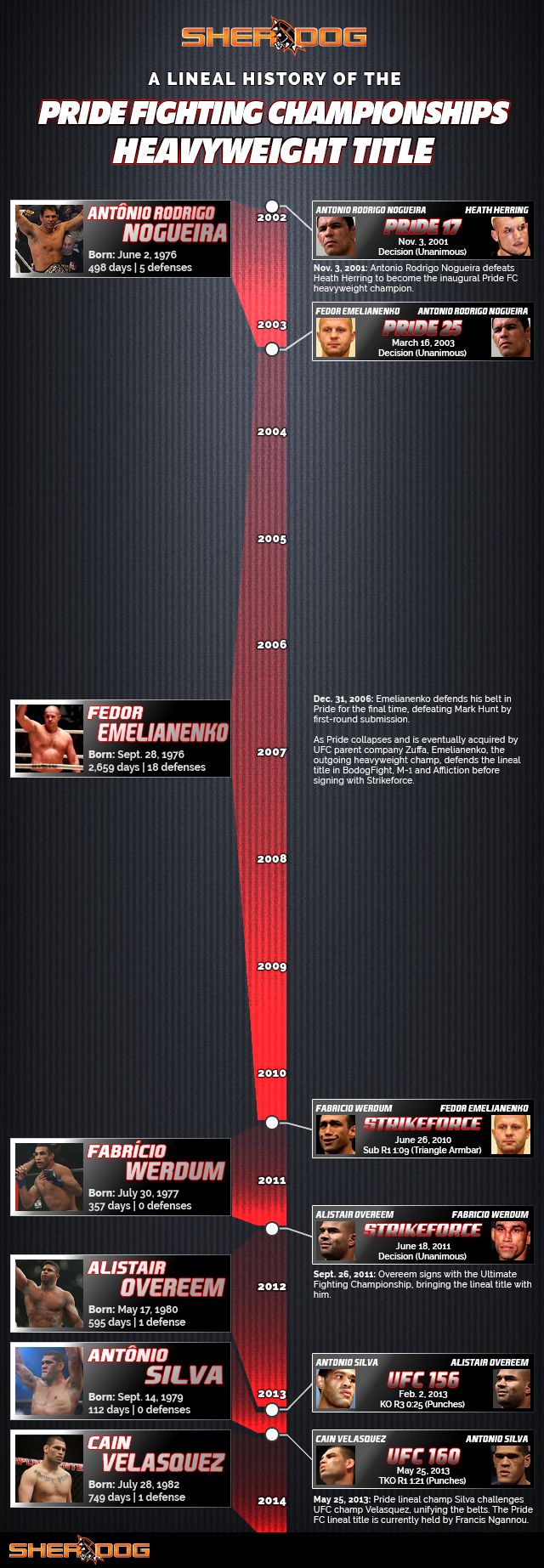This Saturday, the legendary Fedor
Emelianenko takes on Timothy
Johnson in the main event of Bellator 269, in what the 45-year-old Russian
has claimed will be his penultimate mixed martial arts contest.
Whether we are in for the glorious valedictory of an all-time great
in front of an adoring Russian crowd, or a sobering reminder that
Father Time comes for us all, only time will tell. In either case,
this week seemed like an appropriate time to revisit — with a
historical twist — the title that will forever be intertwined with
the legacy of “The Last Emperor.”
“To be the champ, you’ve got to beat the
champ.”
That quote has been thrown around in conversations about MMA for
many years, and boxing for many more, in a variety of different
contexts. While some of the arguments it has been used to prop up
are specious — please spare me the idea that an incumbent belt
holder should receive the benefit of the doubt in close fights — I
do have an appreciation for the historical heft and unassailable
validity of a lineal approach to championships. Hence this series
of infographics tracing the wanderings of famous belts long thought
defunct.
Pride Fighting Championships graced the planet from 1997 to 2007 and was arguably the world’s premier mixed martial arts promotion for much of that time, but it did not crown a heavyweight champion until nearly halfway into its existence.
The rules of this series are few, and based on a simple principle: To the extent possible, the title can only be passed from one fighter to another in the ring or cage. The belt cannot be stripped or abandoned, and there’s no such thing as a “non-title fight.” Emelianenko, the man basically synonymous with the Pride heavyweight belt, only notched five official title defenses despite winning 18 straight fights (with one no-contest) after becoming champ, which was silly even in the real world. Promotions don’t matter; if Emelianenko had lost one of his one-off fights in Inoki Genome Federation or Rings…well, that would have been a problem. If a fighter retires while holding the lineal belt, the belt is retired.
Here is a lineal history of the Pride Fighting Championships heavyweight title, from its inception in November 2001 until the present day or, more accurately, until it merged with the UFC heavyweight title in 2013. Even if the promotion shuttered its doors over 14 years ago, to coin another famous phrase sometimes twisted into unintended meanings: Pride never die, baby.

Advertisement
Pride Fighting Championships graced the planet from 1997 to 2007 and was arguably the world’s premier mixed martial arts promotion for much of that time, but it did not crown a heavyweight champion until nearly halfway into its existence.
The rules of this series are few, and based on a simple principle: To the extent possible, the title can only be passed from one fighter to another in the ring or cage. The belt cannot be stripped or abandoned, and there’s no such thing as a “non-title fight.” Emelianenko, the man basically synonymous with the Pride heavyweight belt, only notched five official title defenses despite winning 18 straight fights (with one no-contest) after becoming champ, which was silly even in the real world. Promotions don’t matter; if Emelianenko had lost one of his one-off fights in Inoki Genome Federation or Rings…well, that would have been a problem. If a fighter retires while holding the lineal belt, the belt is retired.
Here is a lineal history of the Pride Fighting Championships heavyweight title, from its inception in November 2001 until the present day or, more accurately, until it merged with the UFC heavyweight title in 2013. Even if the promotion shuttered its doors over 14 years ago, to coin another famous phrase sometimes twisted into unintended meanings: Pride never die, baby.

Ben
Duffy/Sherdog.com illustration
Related Articles






